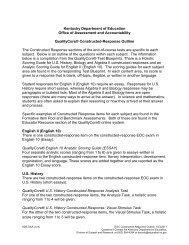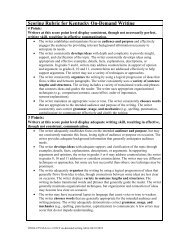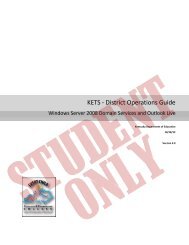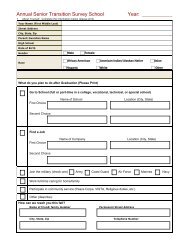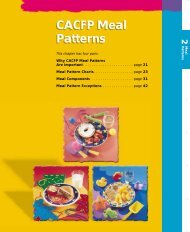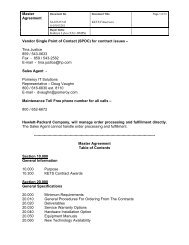Standards with Progressions grades K-HS v. 1.3 - Kentucky ...
Standards with Progressions grades K-HS v. 1.3 - Kentucky ...
Standards with Progressions grades K-HS v. 1.3 - Kentucky ...
- No tags were found...
You also want an ePaper? Increase the reach of your titles
YUMPU automatically turns print PDFs into web optimized ePapers that Google loves.
Eighth Grade <strong>Standards</strong> (2 pages)<br />
The Number System<br />
Know that there are numbers that are not rational, and approximate them by rational numbers.<br />
8.NS.1: Understand informally that every number has a decimal expansion; the rational numbers are those <strong>with</strong> decimal expansions that terminate in 0s or eventually repeat. Know that other numbers are called<br />
irrational.<br />
8.NS.2: Use rational approximations of irrational numbers to compare the size of irrational numbers, locate them approximately on a number line diagram, and estimate the value of expressions (e.g., π 2 ). For example, by<br />
truncating the decimal expansion of , show that is between 1 and 2, then between 1.4 and 1.5, and explain how to continue on to get better approximations.<br />
Expressions and Equations<br />
Work <strong>with</strong> radicals and integer exponents.<br />
8.EE.1: Know and apply the properties of integer exponents to generate equivalent numerical expressions. For example, 3 2 × 3 –5 = 3 –3 = 1/3 3 = 1/27.<br />
8.EE.2: Use square root and cube root symbols to represent solutions to equations of the form x 2 = p and x 3 = p, where p is a positive rational number. Evaluate square roots of small perfect squares and cube roots of<br />
small perfect cubes. Know that is irrational.<br />
8.EE.3: Use numbers expressed in the form of a single digit times an integer power of 10 to estimate very large or very small quantities, and to express how many times as much one is than the other. For example,<br />
estimate the population of the United States as 3 × 10 8 and the population of the world as 7 × 10 9 , and determine that the world population is more than 20 times larger.<br />
8.EE.4: Perform operations <strong>with</strong> numbers expressed in scientific notation, including problems where both decimal and scientific notation are used. Use scientific notation and choose units of appropriate size for<br />
measurements of very large or very small quantities (e.g., use millimeters per year for seafloor spreading). Interpret scientific notation that has been generated by technology.<br />
Analyze and solve linear equations and pairs of simultaneous linear equations.<br />
8.EE.5: Graph proportional relationships, interpreting the unit rate as the slope of the graph. Compare two different proportional relationships represented in different ways. For example, compare a distance-time graph<br />
to a distance-time equation to determine which of two moving objects has greater speed.<br />
8.EE.6: Use similar triangles to explain why the slope m is the same between any two distinct points on a non-vertical line in the coordinate plane; derive the equation y = mx for a line through the origin and the equation<br />
y = mx + b for a line intercepting the vertical axis at b.<br />
Understand the connections between proportional relationships, lines, and linear equations.<br />
8.EE.7: Solve linear equations in one variable.<br />
a. Give examples of linear equations in one variable <strong>with</strong> one solution, infinitely many solutions, or no solutions. Show which of these possibilities is the case by successively transforming the given equation into<br />
simpler forms, until an equivalent equation of the form x = a, a = a, or a = b results (where a and b are different numbers).<br />
b. Solve linear equations <strong>with</strong> rational number coefficients, including equations whose solutions require expanding expressions using the distributive property and collecting like terms.<br />
8.EE.8: Analyze and solve pairs of simultaneous linear equations.<br />
a. Understand that solutions to a system of two linear equations in two variables correspond to points of intersection of their graphs, because points of intersection satisfy both equations simultaneously.<br />
b. Solve systems of two linear equations in two variables algebraically, and estimate solutions by graphing the equations. Solve simple cases by inspection. For example, 3x + 2y = 5 and 3x + 2y = 6 have no<br />
solution because 3x + 2y cannot simultaneously be 5 and 6.<br />
c. Solve real-world and mathematical problems leading to two linear equations in two variables. For example, given coordinates for two pairs of points, determine whether the line through the first pair of points<br />
intersects the line through the second pair.<br />
Functions<br />
Define, evaluate, and compare functions.<br />
8.F.1: Understand that a function is a rule that assigns to each input exactly one output. The graph of a function is the set of ordered pairs consisting of an input and the corresponding output. (Note: Function notation<br />
is not required in Grade 8.)<br />
8.F.2: Compare properties of two functions each represented in a different way (algebraically, graphically, numerically in tables, or by verbal descriptions). For example, given a linear function represented by a table of<br />
values and a linear function represented by an algebraic expression, determine which function has the greater rate of change.<br />
8.F.3: Interpret the equation y = mx + b as defining a linear function, whose graph is a straight line; give examples of functions that are not linear. For example, the function A = s 2 giving the area of a square as a function<br />
of its side length is not linear because its graph contains the points (1,1), (2,4) and (3,9), which are not on a straight line.<br />
Use functions to model relationships between quantities.<br />
8.F.4: Construct a function to model a linear relationship between two quantities. Determine the rate of change and initial value of the function from a description of a relationship or from two (x, y) values, including<br />
reading these from a table or from a graph. Interpret the rate of change and initial value of a linear function in terms of the situation it models, and in terms of its graph or a table of values.<br />
8.F.5: Describe qualitatively the functional relationship between two quantities by analyzing a graph (e.g., where the function is increasing or decreasing, linear or nonlinear). Sketch a graph that exhibits the qualitative<br />
features of a function that has been described verbally.<br />
Geometry<br />
Understand congruence and similarity using physical models, transparencies, or geometry software.<br />
8.G.1: Verify experimentally the properties of rotations, reflections, and translations:<br />
a. Lines are taken to lines, and line segments to line segments of the same length.<br />
b. Angles are taken to angles of the same measure.<br />
c. Parallel lines are taken to parallel lines.<br />
8.G.2: Understand that a two-dimensional figure is congruent to another if the second can be obtained from the first by a sequence of rotations, reflections, and translations; given two congruent figures, describe a<br />
sequence that exhibits the congruence between them.<br />
8.G.3: Describe the effect of dilations, translations, rotations, and reflections on two-dimensional figures using coordinates.<br />
8.G.4: Understand that a two-dimensional figure is similar to another if the second can be obtained from the first by a sequence of rotations, reflections, translations, and dilations; given two similar two-dimensional<br />
figures, describe a sequence that exhibits the similarity between them.<br />
<strong>Kentucky</strong> Department of Education<br />
49 | P a g e




